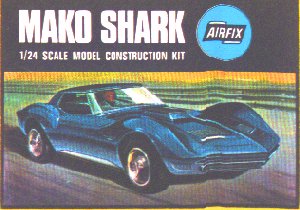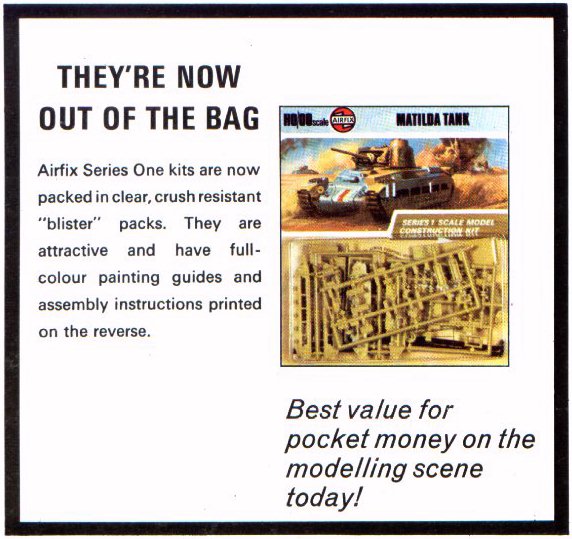|
|
|
|
|
I receive many e-mails asking me to explain the terms "type 1" or "type 3" etc when it comes to Airfix plastic bag styles.
These terms refer to the layout, artwork and design of the header card. The header card is the piece of folded paper that is stapled to the top of the plastic bag that contains the kit parts. On the front of the header card is the name of the kit and a picture of the aircraft, ship or whatever. On the reverse side is a description of the real item. Inside are the assembly instructions. Airfix changed the design of its header cards over the years. It is from the design of the header card that you can determine the age of the kit, and hence its rarity, collectability and (I guess) value.
The following is not a comprehensive catalogue of Airfix plastic bags. I will not try to describe all the various "flavours" of each type. There are, for example, variants known as "type 2a" or "type 3b".
OK? Let's start.
Airfix models were first available in the early 1950s and the plastic bag
headers were of various styles until about 1956/7 when they standardised
on the Type 1. Enthusiasts refer to all these early designs collectively
as "Type 0". A good example of a Type 0 is the "scroll-style"
header cards on the early ship series like the Santa Maria etc (see below).
| Type 0 |  This is an example of a Type 0 header, from the early ship range. There
are actually two slightly different versions of this type of Ship "scroll"
header card, the second version being more close to the classic Type 1
header shown below. This is an example of a Type 0 header, from the early ship range. There
are actually two slightly different versions of this type of Ship "scroll"
header card, the second version being more close to the classic Type 1
header shown below. |
| Type 0 |  This
is another example of a Type 0 header. It is the General Store kit from
the Airfix Trackside series This
is another example of a Type 0 header. It is the General Store kit from
the Airfix Trackside series |
| Type 1 |  This
is a example of an early Type 1 header. The artwork is a crude line drawing,
and the design is split into red and white halves. The Airfix logo is a
scroll which also contains the words "Products in Plastic". Because of
their age, these early Type 1 are real collectors items now. Header cards
by themselves (no kit!) trade at almost $10 each. This
is a example of an early Type 1 header. The artwork is a crude line drawing,
and the design is split into red and white halves. The Airfix logo is a
scroll which also contains the words "Products in Plastic". Because of
their age, these early Type 1 are real collectors items now. Header cards
by themselves (no kit!) trade at almost $10 each. |
| Type 1a |  Later Type 1s for the Series 2 kits were a more sophisticated style, but the artwork is still pretty simple. The example shown (Supermarine Walrus) is a Series 2 aircraft kit. As these kits were physically bigger than most Series 1 kits, the plastic bags and hence the Header Cards are also of a larger size. Original Series 2 were plastic bags, but quickly changed to boxes. Series 2 plastic bags are therefore something of a rarity and should be treated with respect ! Later Type 1s for the Series 2 kits were a more sophisticated style, but the artwork is still pretty simple. The example shown (Supermarine Walrus) is a Series 2 aircraft kit. As these kits were physically bigger than most Series 1 kits, the plastic bags and hence the Header Cards are also of a larger size. Original Series 2 were plastic bags, but quickly changed to boxes. Series 2 plastic bags are therefore something of a rarity and should be treated with respect ! |
| Type 2 |  This Type 2 style was introduced in about 1959/60. The card is again split
vertically in two colours with another vertical coloured stripe between
the two halves. The Airfix logo looses the words "Products in Plastic".
A variant of the Type 2 had a multicoloured vertical stripe - this was
usually seen on the military vehicle series. The military vehicle variant
can be seen on the 25 Pounder kit header sheet shown on the Instruction
Sheet page of this site. This Type 2 style was introduced in about 1959/60. The card is again split
vertically in two colours with another vertical coloured stripe between
the two halves. The Airfix logo looses the words "Products in Plastic".
A variant of the Type 2 had a multicoloured vertical stripe - this was
usually seen on the military vehicle series. The military vehicle variant
can be seen on the 25 Pounder kit header sheet shown on the Instruction
Sheet page of this site. |
| Type 3 |  The Type 3 was introduced in the Autumn of 1963. It is the most well known style of plastic bag kit as this design lasted into the 1970s. Almost the complete sheet is taken up by the brilliant artwork of Roy Cross. "Airfix - 1/72 scale" with the model's name occupies a small white-background segment. There are two main variants of the Type 3 - one in which the Airfix logo has a background of thin black stripes and another where the kit name appears separately super-imposed on the artwork. For more information on Type 3 Header Cards click here The Type 3 was introduced in the Autumn of 1963. It is the most well known style of plastic bag kit as this design lasted into the 1970s. Almost the complete sheet is taken up by the brilliant artwork of Roy Cross. "Airfix - 1/72 scale" with the model's name occupies a small white-background segment. There are two main variants of the Type 3 - one in which the Airfix logo has a background of thin black stripes and another where the kit name appears separately super-imposed on the artwork. For more information on Type 3 Header Cards click here |
| Type 4 |  The Type 4 was the last plastic bag design before the blister packs were
introduced in 1973. The Type 4 plastic bag is not well known. Although
I know of one person who only collects Type 4 kits, there are also keen
Airfix people who never realised that the Type 4 bag existed. I believe
the Type 4 was only used on 3 kits - this Lysander, the Brewster Buffalo
and the Cessna Bird-Dog The Type 4 was the last plastic bag design before the blister packs were
introduced in 1973. The Type 4 plastic bag is not well known. Although
I know of one person who only collects Type 4 kits, there are also keen
Airfix people who never realised that the Type 4 bag existed. I believe
the Type 4 was only used on 3 kits - this Lysander, the Brewster Buffalo
and the Cessna Bird-Dog |
And, of course, there are other minor flavours and varieties. Changes from one type to another was not consistent across the ranges, and the Catalogues add to the confusion because sometimes old photographs were used, incorrectly suggesting a style lingered on into later years.
Boxes followed the styles of the Type 2, Type 3 and Type 4 in approximately the same time frame. Additional information on box types follows:

And here's the end of the Airfix plastic bag !!

|
|
|
|
|